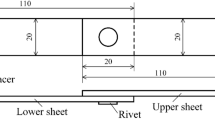Abstract
Self-piercing riveting (SPR) is a high-speed mechanical fastening technique which is suitable for point joining advanced lightweight sheet materials. This paper reports on research into the mechanical properties of single and multiple-rivet SPR joints in aluminum alloy 5052 sheet materials. Static and fatigue tests were conducted in order to understand the effect of varying the number and distribution pattern of rivets in such joints. A statistical analysis was performed to examine the rationality of test data and the strength reliability of the joints. The failure mechanism of the joints was studied by looking at the fracture surfaces of multiple-rivet SPR joints using scanning electron microscopy (SEM) and energy-dispersive X-ray (EDX) techniques. The results of mechanical experiments showed that the static strength and fatigue life of multiple-rivet SPR joints are significantly greater than for single-rivet SPR joints. Furthermore, the SEM and EDX examination results suggest that the failure characteristics are different for multiple-rivet SPR joints with the same number of rivets but different rivet distribution patterns. That the mechanical properties of the multiple-rivet SPR joints can be influenced not only by the rivet number but also rivet distribution pattern is an important conclusion. The strength and failure models are discussed and illustrated with case studies for different SPR joints.
Similar content being viewed by others
References
He X, Gu F, Ball A (2014) A review of numerical analysis of friction stir welding. Prog Mater Sci 65:1–66
He X (2012) Finite element analysis of laser welding: a state of art review. Mater Manuf Process 27:1354–1365
He X, Gu F, Ball A (2012) Recent development in finite element analysis of self-piercing riveted joints. Int J Adv Manuf Tech 58(5–8):643–649
Mucha J (2011) A study of quality parameters and behaviour of self-piercing riveted aluminium sheets with different joining conditions. Stroj Vestn-J Mech E 57(4):323–333
He X, Pearson I, Young K (2008) Self-pierce riveting for sheet materials: state of the art. J Mater Process Technol 199(1–3):27–36
Johnson P, Cullen J, Sharples L, Shaw A, AL-Shamma’a A (2009) Online visual measurement of self-pierce riveting systems to help determine the quality of the mechanical interlock. Measurement 42(5):661–667
Fu M, Mallick P (2003) Fatigue of self-piercing riveted joints in aluminum alloy 6111. Int J Fatigue 25(3):183–189
Sun X, Stephens E, Khaleel M (2007) Fatigue behaviors of self-piercing rivets joining similar and dissimilar sheet metals. Int J Fatigue 29(2):370–386
Khanna S, Long X, Krishnamoorthy S, Agrawal H (2006) Fatigue properties and failure characterization of self-piercing riveted 6111 aluminium sheet joints. Sci Technol Weld Join 11(5):544–549
Han L, Chrysanthou A, Young K, O’sullivan J (2006) Characterization of fretting fatigue in self-piercing riveted aluminium alloy sheets. Fatigue Fract Eng Master Struct 29(8):646–654
He X (2011) Coefficient of variation and its application to strength prediction of self-piercing riveted joints. Sci Res Essay 6:6850–6855
Iyer K, Hu S, Brittman F, Wang P, Hayden D, Marin S (2005) Fatigue of single- and double-rivet self-piercing riveted lap joints. Fatigue Fract Eng Master Struct 28(11):997–1007
Li D, Han L, Thornton M, Shergold M (2012) Influence of rivet to sheet edge distance on fatigue strength of self-piercing riveted aluminium joints. Mater Sci Eng A 558:242–252
Hoang N, Hanssen A, Langseth M, Porcaro R (2012) Structural behaviour of aluminium self-piercing riveted joints: an experimental and numerical investigation. Int J Solids Struct 49(23–24):3211–3223
He X, Xing B, Zeng K, Gu F, Ball A (2013) Numerical and experimental investigations of self-piercing riveting. Int J Adv Manuf Technol 69(1–4):715–721
He X, Oyadiji S (2001) Application of coefficient of variation in reliability-based mechanical design and manufacture. J Mater Process Technol 119(1–3):374–378
Karbhari V, Wang Q (2007) Influence of triaxial braid denier on ribbon-based fiber reinforced dental composites. Dent Mater 23(8):969–976
Ishii K, Imanaka M, Nakayama H, Kodama H (1998) Fatigue failure criterion of adhesively bonded CFRP/metal joints under multiaxial stress conditions. Compos A: Appl Sci Manuf 29(4):415–422
Pape J, Neu R (1999) Influence of contact configuration in fretting fatigue testing. Wear 225:1205–1214
Haque R, Beynon J, Durandet Y, Kirstein O, Blacket S (2012) Feasibility of measuring residual stress profile in different self-pierce riveted joints. Sci Technol Weld Join 17(1):60–68
Author information
Authors and Affiliations
Corresponding author
Rights and permissions
About this article
Cite this article
Xing, B., He, X., Zeng, K. et al. Mechanical properties of self-piercing riveted joints in aluminum alloy 5052. Int J Adv Manuf Technol 75, 351–361 (2014). https://doi.org/10.1007/s00170-014-6152-5
Received:
Accepted:
Published:
Issue Date:
DOI: https://doi.org/10.1007/s00170-014-6152-5




